Will Power-Hungry Data Centers Increase Pollution in Wisconsin?
Critics say We Energies gas plant would hike pollution, energy costs for decades.
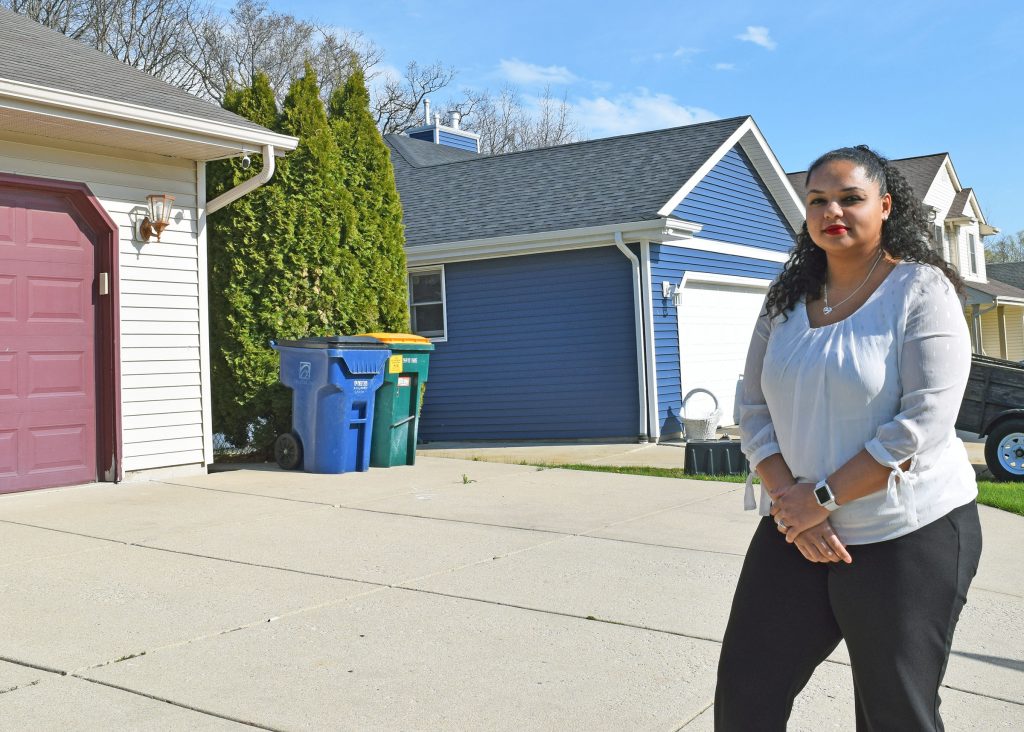
Brianna Allen Kaiser stands in front of her home near the South Oak Creek coal plant owned by We Energies. She opposes the utility’s plan to build a roughly $1.2 billion gas plant to meet growing power demand that’s largely driven by data centers. Evan Casey/WPR
WPR reporters are diving into the development of data centers around Wisconsin and the impacts they could have on the communities where they’re being built and the state as a whole. This story is part two in a four-part series.
In the past decade, black dust has settled on cars and homes surrounding the South Oak Creek coal plant in southeastern Wisconsin. Brianna Allen Kaiser lives a few blocks away from the facility owned by We Energies with her husband Garrett and son Logan.
“It makes me very nervous and also scared for my own child, who is only 12,” said Kaiser, “of what his future looks like if we just continue to allow big companies like this to come in and pollute the air.”
We Energies has proposed a more than $2 billion plan to build new natural gas infrastructure, including a roughly $1.2 billion natural gas-fired power plant at its Oak Creek site. The utility has noted the gas plant would produce far less pollution than its aging coal units, cutting emissions by more than 3.5 million tons. But Kaiser said renewable energy is a far better option.
“Corporations like Microsoft, which is why they want to build this plant, have the money to invest in renewable energy,” she said. “I feel that that’s where we need to go.”
Microsoft announced last year it’s investing $3.3 billion into its Mount Pleasant data center campus, the first phase of which is expected to come online in 2026. We Energies said its plans are driven by economic growth that mostly stems from large customers like data centers. As developers pursue data centers in Wisconsin, that’s raising concerns about environmental impacts tied to their operations.
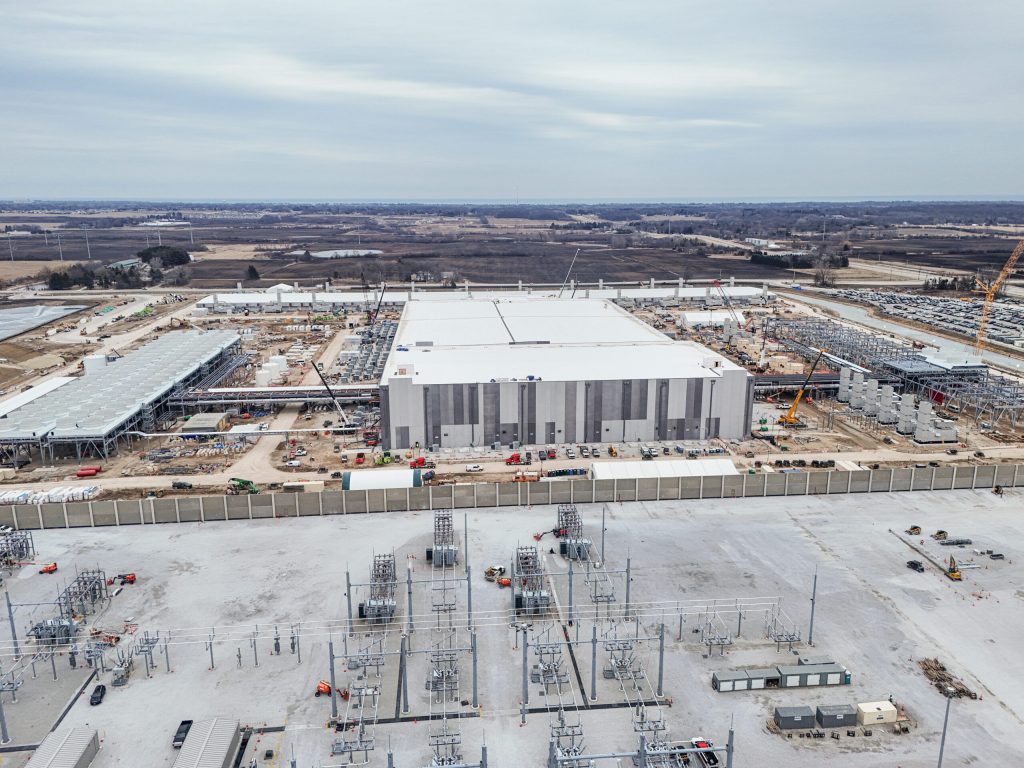
Construction is ongoing on the first phase of Microsoft’s data center project in Mount Pleasant on March 11, 2025. Photo courtesy of Microsoft
AI boom prompts buildout of energy-intensive data centers
The rapid rise of artificial intelligence is driving demand for data centers that require vast amounts of power and water to operate. A 2024 federal report found data centers consumed about 4.4 percent of the nation’s electricity in 2023 and that could nearly triple to 12 percent by 2028.
Last year, Microsoft reported it used 24 million megawatt-hours of energy in 2023, largely driven by electricity use for its data centers. That’s more than the power consumed by countries like Ghana or Jordan, according to data from the International Energy Agency.
Dan Krueger is executive vice president of infrastructure and generation planning for WEC Energy Group, which owns the utility. He said they’re forecasting 1,800 megawatts of new power demand in southeastern Wisconsin with the majority of that coming from Microsoft.
As a result, We Energies has proposed a 1,100-megawatt gas-fired power plant in Oak Creek and a 128-megawatt gas facility in the Kenosha County town of Paris to meet growing power demand. If approved, the projects are expected to be completed in 2027 and 2028.
“This set of new plants that we’re planning produce far less emissions, use less water, meet demand for current and future load growth and really should support economic development for all of us here in Wisconsin,” Krueger said.
Although, he noted its power projections don’t include a proposal from developer Cloverleaf Infrastructure to build a data center in Port Washington that would require roughly double the amount of power they’re forecasting for Microsoft.
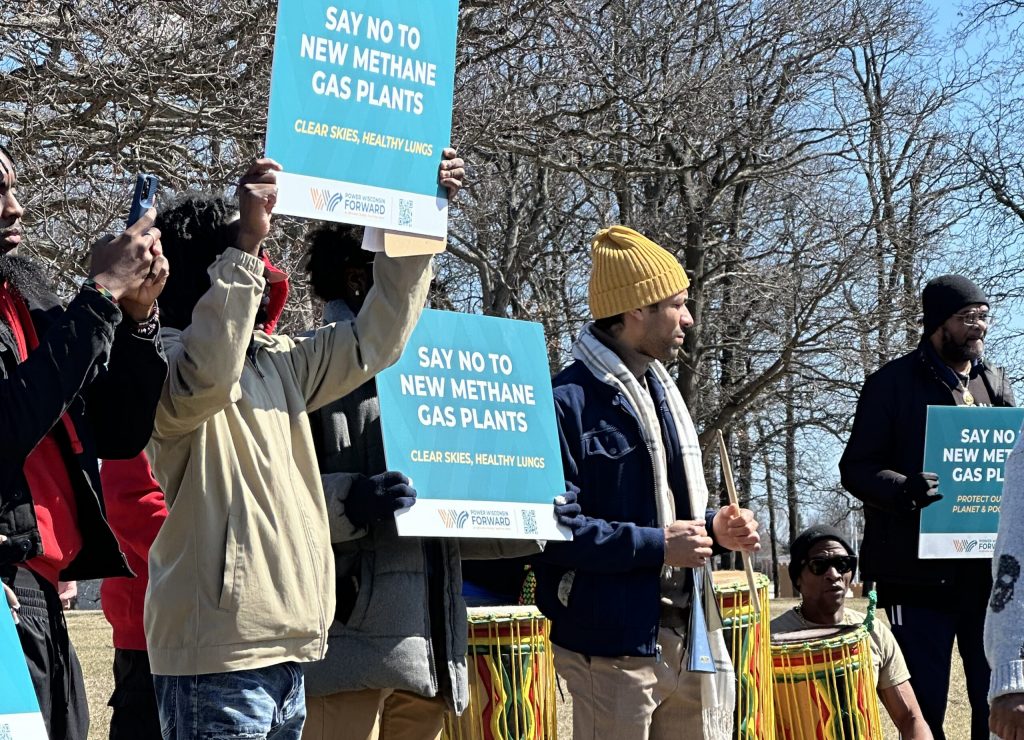
People hold signs calling on the Public Service Commission to deny the approval of a new natural gas plant in Oak Creek ahead of a public hearing on the project Tuesday, March 25, 2025. Photo courtesy of Sierra Club Wisconsin
Environmental advocates want clean energy to power data centers
Amid rising energy demand from data centers, more than a dozen advocacy groups have called on Microsoft to power its operations with clean energy, including Clean Wisconsin.
“By building and investing in these plants, we are locking in potentially decades of further burning of fossil fuels with the air pollution impacts, as well as sending us on a path that does not mitigate against the worst of climate change,” said Ciaran Gallagher, the group’s energy and air manager.
In a statement, Microsoft said it’s working with the utility to bring new infrastructure online for the Mount Pleasant campus and investing to bring new sources of carbon-free electricity onto the regional grid that will match power consumed by its data centers.
“This is critical to support our climate sustainability goals, as it is not currently possible to deliver to Mount Pleasant all the electricity we need strictly from carbon-free sources,” a Microsoft spokesperson wrote.
Microsoft said it expects to meet a goal to match 100 percent of carbon-emitting electricity with renewable energy by the end of this year. By 2027, Microsoft said it will exceed 4,000 megawatts of energy flowing to the regional grid or enough to power more than 3 million homes.

Brianna Allen Kaiser stands in front of her home near the South Oak Creek coal plant owned by We Energies. As its last coal units come offline this year, the utility is proposing a roughly $1.2 billion gas plant to meet growing power demand that’s largely driven by data centers. Evan Casey/WPR
Backlogs block clean energy projects from tying into the grid
Energy experts say the rules for power grids favor large fossil fuel plants. A 2024 study found a backlog of nearly 2,600 gigawatts of mostly clean energy resources and storage capacity, more than double the installed capacity of power plants nationwide. Renewable energy projects also see higher costs to interconnect to the grid than fossil fuel plants.
John Quigley, a senior fellow at the University of Pennsylvania’s Kleinman Center for Energy Policy, said allowing fossil fuel projects to jump to the head of the line when connecting to the grid only exacerbates problems over the long haul.
Health advocates add We Energies’ proposed gas plants could cause up to $5.7 billion in health costs nationwide over their 30-year life span due to pollution, according to an analysis commissioned by Healthy Climate Wisconsin and the Union of Concerned Scientists.
Abby Novinska-Lois, executive director of Healthy Climate Wisconsin, noted that the region where gas plants would be built has some of the highest asthma hospitalization rates and violates federal air quality standards for ozone pollution.
“We can have batteries. We can have clean energy,” Novinska-Lois said. “We have an opportunity to save lives.”
We Energies plans to invest $9.1 billion in clean energy projects by 2029. Even so, utility officials say the Oak Creek gas plant would save customers an average of $413 million compared to alternatives like battery storage.
Critics like the Citizens Utility Board of Wisconsin argue the utility inflated the costs of batteries and energy efficiency programs in its modeling. We Energies contends it has observed cost increases on clean energy projects due to inflation and market factors outside their control.
Staff with the Public Service Commission have indicated that other options like 1,100 megawatts of wind could be a cost-effective alternative to the Oak Creek gas plant, but We Energies told regulators it’s unlikely to permit and build enough wind capacity by the time its first gas turbines would go online in 2027.
Clean energy advocates point to mounting backlogs to secure equipment for gas plants, but Krueger said the utility has already obtained turbines for the proposed Oak Creek gas plant. He added the facility would only run 10 to 20 percent of the time compared to its older coal-fired units, reducing emissions and filling the gap when renewables and storage are unable to meet demand.
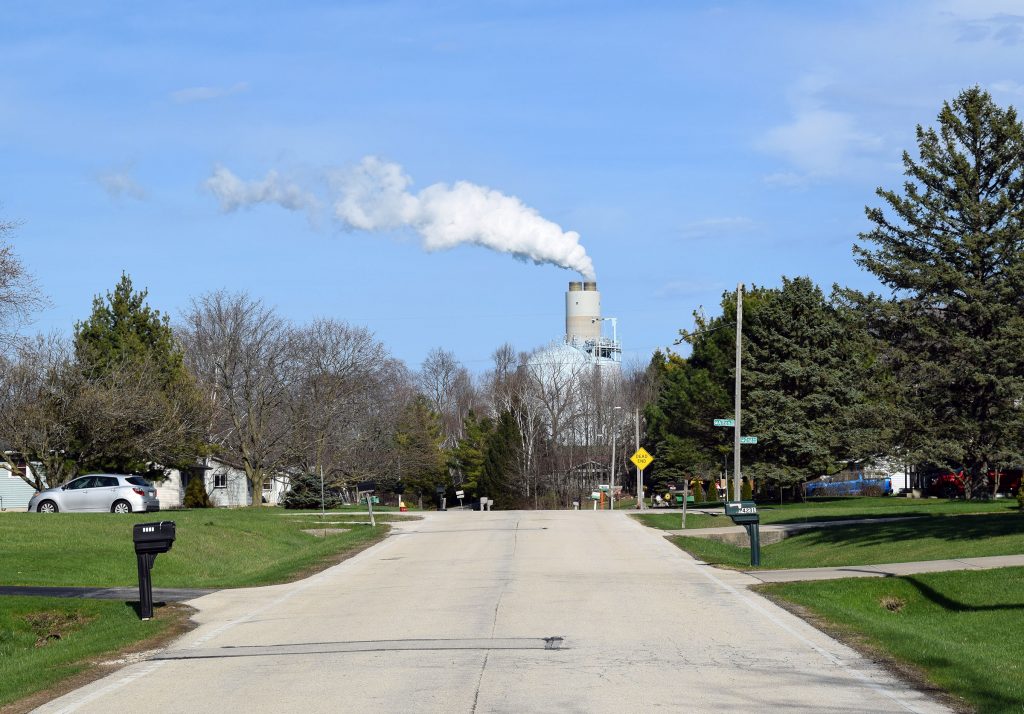
The Oak Creek power plant owned by We Energies can be seen from a nearby residential neighborhood. The utility is proposing to build a gas plant in its place to meet suring energy demand as tech companies build data centers in southeastern Wisconsin. Evan Casey/WPR
We Energies, Microsoft say their plans require less water
Beyond carbon reductions, Krueger said the Oak Creek gas plant would use and return thousands of gallons of Lake Michigan water each day compared to roughly 1 billion gallons daily for cooling its coal-fired units. We Energies is permitted to withdraw more than 2 billion gallons daily. Last year, its Elm Road and Oak Creek facilities withdrew more than 469 billion gallons of water.
In December, the company said most of its Mount Pleasant data center campus will use a new closed-loop system design that will consume zero water for cooling. Microsoft said the new liquid cooling technology will save 33 million gallons of water per data center each year by using cooling chemicals and recycled water.
“This means, we will fill the water tanks and pipes one time when the datacenter becomes operational, and that water will remain in the closed loop system to be reused over time for cooling,” the company’s spokesperson wrote.
The rest of the data center campus would use outside air for cooling, and water would only be used for cooling during very warm temperatures.
The system is expected to use a peak of 350,000 gallons per day on the hottest days of the year during the months of May through September.
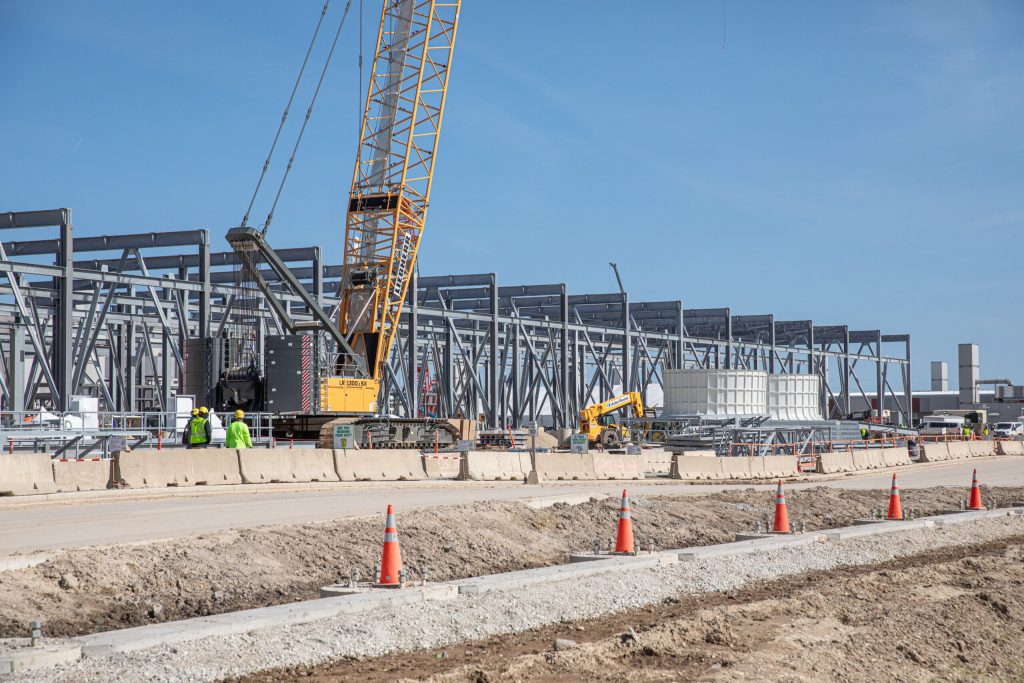
Construction is ongoing on the first phase of Microsoft’s data center project in Mount Pleasant on March 11, 2025. Photo courtesy of Microsoft
Does the need exist for more generation to power data centers?
Developers have been racing to build data centers, but the pace of that buildout has shifted in recent months. While construction of Microsoft’s first phase of its data center campus is on track, the company paused work on a 900-acre portion of its Mount Pleasant campus in March. It’s also “slowing or pausing” projects elsewhere.
The buildout of data centers has faced uncertainty amid tariffs, rising construction costs and advancements in chip design that could cut electricity use needed for data centers. Critics of We Energies’ plan question whether there’s still a need for the utility’s proposed 1,100-megawatt gas plant, highlighting no service agreements exist for the projected demand.
Valeria Teran, principal program manager for Microsoft, said in a March filing that it’s standing by its requested power demand to support its growth.
Even with gains in efficiency, Brian Janous, co-founder of Cloverleaf Infrastructure and a former Microsoft executive, said that’s likely to drive more data centers rather than reduce the need for them.
“Now we can more efficiently do things that we couldn’t have done before with the levels of computation we have, so I’m very bullish on the continued need for more computation,” Janous said.
Customer advocates voice concerns about costs tied to data centers
As developers pursue projects in Wisconsin, customer advocates point to a recent Harvard paper that shows the costs for powering data centers could be shifted to ratepayers, including Tom Content, executive director of the Citizens Utility Board.
“There are real extreme examples where customers — homeowners, renters and businesses — around their states are subsidizing affluent tech companies,” Content said.
We Energies provides electricity to about 1.1 million customers in Wisconsin. In Milwaukee, the median energy burden, or share of household income that goes toward energy costs, has declined in recent years. However, a greater share of Black and Hispanic residents reside in neighborhoods that face higher energy costs compared to their white counterparts.
Antonio Butts, executive director of Walnut Way Conservation Corp, said customers are already struggling with affordability amid rising costs and rate hikes. Customer advocates say utility bills have increased 30 percent or more in recent years.
“We want to see that transparently laid out and projected in a way that We Energies’ customers can understand exactly who would bear the burden of the cost,” Butts said.
The Harvard study recommends requiring utilities to serve data centers through tariffs or special rates. We Energies recently asked state utility regulators to approve that kind of arrangement, which would require companies to pay for infrastructure tied to their data center developments. Under the proposal, large customers like Microsoft and Cloverleaf that need at least 500 megawatts of power would be responsible for those costs.
“The whole point of it is the power plants, the distribution lines, the high voltage lines, they’re working hand-in-hand with us to make sure that all those costs related to them are paid by them, and there is no cost-shifting to other customers,” Krueger said.
Content said We Energies customers are already paying for a shuttered coal plant in Pleasant Prairie that became uneconomical and fears ratepayers may face the same fate with proposed gas plants.
Brianna Allen Kaiser said her utility bill has been slowly rising over time and runs more than $200 each month. She said the proposed Oak Creek gas plant is too costly for taxpayers and public health. “Our community members need to fight for better,” Kaiser said. “Because we deserve better.”
Editor’s note: Evan Casey, Joe Schulz and Nick Rommel contributed reporting for this story.
Power-hungry data centers are prompting new gas plant proposals. Critics say that would lock in pollution and higher costs for decades. was originally published by Wisconsin Public Radio.
If you think stories like this are important, become a member of Urban Milwaukee and help support real, independent journalism. Plus you get some cool added benefits.
The Impact of Data Centers
-
An Iowa City With Five Microsoft Data Center Complexes Reveals What Wisconsin Can Expect
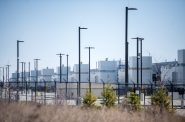 May 15th, 2025 by Evan Casey
May 15th, 2025 by Evan Casey
-
Will Huge Data Centers Boost Wisconsin’s Tax Revenues?
 May 14th, 2025 by Joe Schulz
May 14th, 2025 by Joe Schulz
-
What Are Data Centers? How Will They Change Wisconsin?
 May 12th, 2025 by Nick Rommel
May 12th, 2025 by Nick Rommel


















